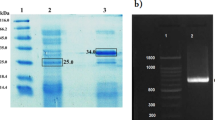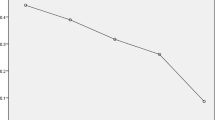Abstract
Two novel parasporin (PS) genes were cloned from Bacillus thuringiensis B0462 strain. One was 100 % identical even in nucleotide sequence level with that of parasporin-1Aa (PS1Aa1) from B. thuringiensis A1190 strain. The other (PS1Ac2) showed significant homology (99 % identity) to that of PS1Ac1 from B. thuringiensis 87-29 strain. The 15 kDa (S113–R250) and 60 kDa (I251–S777) fragments consisting of an active form of PS1Ac2 were expressed as His-tag fusion. Upon purification under denaturing condition and refolding, the recombinant polypeptides were applied to cancer cells to analyze their cytotoxicities. 3-(4,5-Dimethyl-2-thiazoyl)-2,5-diphenyl-2H-tetrazolium bromide assay revealed that either of 15 or 60 kDa polypeptide exhibited no cytotoxicity to HeLa cells, but they became cytotoxic upon mixed together. Our results suggested that PS1Ac2 was responsible for the cytotoxicity of B. thuringiensis B0462 strain, and that the formation of hetero-dimer of 15 and 60 kDa polypeptide was required for their cytotoxicity.




Similar content being viewed by others
References
Altschul SF, Gish W, Miller W, Myers EW, Lipman DJ (1990) Basic local alignment search tool. J Mol Biol 215:403–410
Cannon RJC (1996) Insecticidal crystal proteins of Bacillus thuringiensis. Microbiol Rev 53:242–255
de Maagd R, Bravo A, Crickmore N (2001) How Bacillus thuringiensis has evolved specific toxins to colonize the insect world. Trends Genet 17:193–199
Federici BA (1995) The future of microbial insecticides as vector control agents. J Am Mosq Control Assoc 11:260–268
Hawakawa T, Kanagawa R, Kotani Y, Kimura M, Yamagiwa M, Yamane Y, Takebe S, Sakai H (2007) Parasporin-2Ab, a newly isolated cytotoxic crystal protein from Bacillus thuringiensis. Curr Microbiol 55:278–283
Hayakawa T, Sato S, Iwamoto S, Sudo S, Sakamoto Y, Yamashita T, Uchida M, Matsushima K, Kashino Y, Sakai H (2010) Novel strategy for protein production using a peptide tag derived from Bacillus thuringiensis Cry4Aa. FEBS J 277:2883–2891
Jung Y-C, Mizuki E, Akao T, Cote J-C (2007) Isolation and characterization of a novel Bacillus thuringiensis strain expressing a novel crystal protein with cytocidal activity against human cancer cells. J Appl Microbiol 103:65–79
Katayama H, Yokota H, Akao T, Nakamura O, Ohba M, Mekada E, Mizuki E (2005) Parasporin-1, a novel cytotoxic protein to human cells from non-insecticidal parasporal inclusions of Bacillus thuringiensis. J Biochem 137:17–25
Katayama H, Kusaka Y, Yokota H, Akao T, Kojima M, Nakamura O, Mekada E, Mizuki E (2007) Parasporin-1, a novel cytotoxic protein from Bacillus thuringiensis, induces Ca2+ influx and a sustained elevation of the cytoplasmic Ca2+ concentration in toxin-sensitive cells. J Biol Chem 282:7742–7752
Mizuki E, Ohba M, Akao T, Yamashita S, Saitoh H, Park YS (1999) Unique activity associated with non-insecticidal Bacillus thuringiensis parasporal inclusions: in vitro cell-killing action on human cancer cells. J Appl Microbiol 86:477–486
Mizuki E, Park YS, Saitoh H, Yamashita S, Akao T, Higuchi K, Ohba M (2000) Parasporin, a human leukemic cell-recognizing parasporal protein of Bacillus thuringiensis. Clin Diagn Lab Immunol 7:625–634
Nagamatsu Y, Okamura S, Saitou H, Akao T, Mizuki E (2010) Three Cry toxins in two types from Bacillus thuringiensis strain M019 preferentially kill human hepatocyte cancer and uterus cervix cancer cells. Biosci Biotechnol Biochem 73:494–498
Ohba M (2011) Bacillus thuringiensis diversity in soil and phylloplane. In: Logan NA, De Vos P (eds) Endospore-forming soil bacteria, soil biology, vol 27. Springer, Berlin, pp 215–233
Page RDM (1996) TREEVIEW: an application to display phylogenetic trees on personal computers. Comput Appl Biosci 13:357–358
Schnepf E, Crickmore N, Van Rie J, Lereclus D, Baum J, Feitelson J, Zeigler DR, Dean DH (1998) Bacillus thuringiensis and its pesticidal crystal proteins. Microbiol Mol Biol Rev 62:775–806
Thompson JD, Higgins DG, Gibsom TJ (1994) CLUSTAL W: improving the sensitivity of progressive multiple sequence alignment through sequence weighting, position-specific gap penalties and weight matrix choice. Nucleic Acids Res 22:4673–4680
Uemori A, Ohgushi A, Yasutake K, Maeda M, Mizuki E, Ohba M (2008) Parasporin-1Ab, a novel Bacillus thuringiensis cytotoxin preferentially active on human cancer cells in vitro. Anticancer Res 28:91–96
Yasutake K, Uemori A, Binh ND, Mizuki E, Ohba M (2008) Identification of parasporin genes in Vietnamese isolates of Bacillus thuringiensis. Z Naturforsch 63c:139–143
Acknowledgments
This work was supported, in part, by Grant-in-Aid for Scientific Research (20380036, 23658048 and 24380034).
Author information
Authors and Affiliations
Corresponding author
Electronic supplementary material
Below is the link to the electronic supplementary material.
284_2013_301_MOESM1_ESM.doc
Nucleotide sequence and the deduced amino acid sequence of the ps1Ac2 gene. The ps1Ac2 gene is 2,331 bp in length and codes for a polypeptide of 777 amino acids. Putative ribosome-binding site (RBS) is underlined. The amino acid sequence (XEPPST) detected by protein sequencing is double-underlined. Numerals on the left hand side are the numbers of nucleotide (upper) and amino acids (lower) Supplementary material 1 (DOC 40 kb)
284_2013_301_MOESM2_ESM.doc
Comparison of the deduced amino acid sequence of PS1Ac2 with PS1Aa1 and PS1Ac1. N- and C-termini of 15 and 56 kDa subunits are indicated. Amino acid sequences with underlines indicate five blocks that are amino acid sequences conserved among three-domain Cry toxins. Asterisks and dotted lines indicate identical amino acids and alignment gaps, respectively. Supplementary material 2 (DOC 37 kb)
Rights and permissions
About this article
Cite this article
Kuroda, S., Begum, A., Saga, M. et al. Parasporin 1Ac2, a Novel Cytotoxic Crystal Protein Isolated from Bacillus thuringiensis B0462 Strain. Curr Microbiol 66, 475–480 (2013). https://doi.org/10.1007/s00284-013-0301-1
Received:
Accepted:
Published:
Issue Date:
DOI: https://doi.org/10.1007/s00284-013-0301-1




